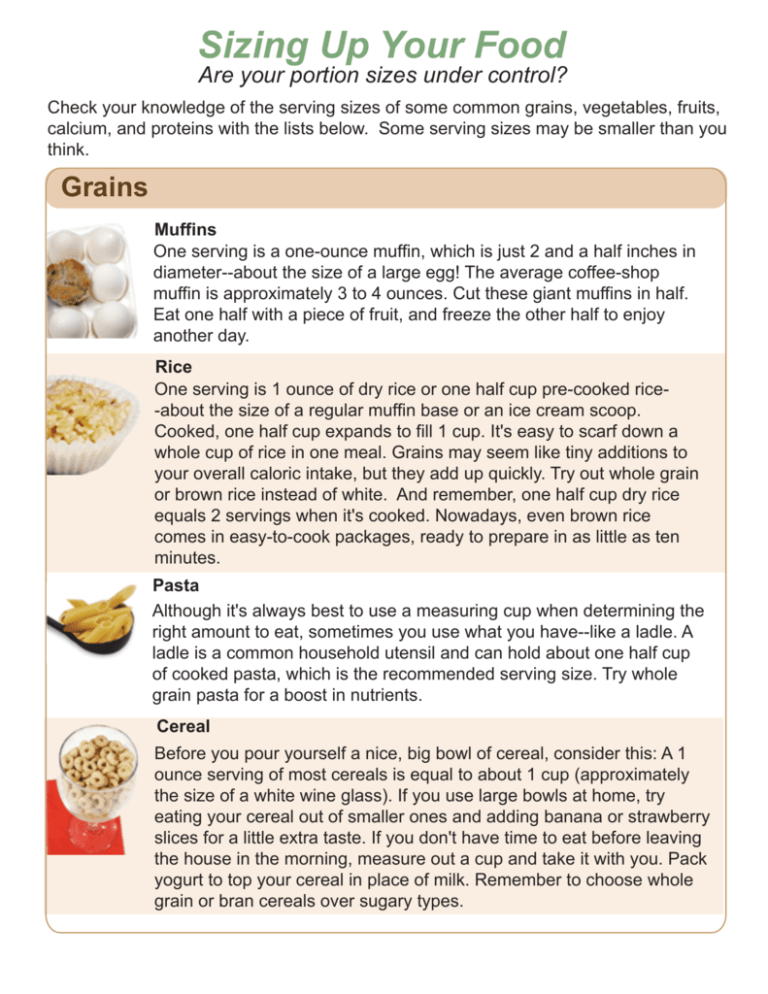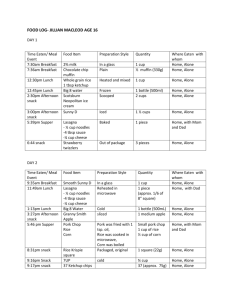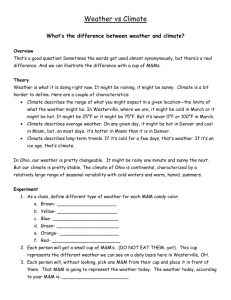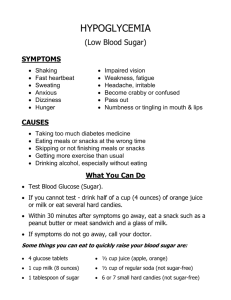Sizing Up Your Food
advertisement

Sizing Up Your Food Are your portion sizes under control? Check your knowledge of the serving sizes of some common grains, vegetables, fruits, calcium, and proteins with the lists below. Some serving sizes may be smaller than you think. Grains Muffins One serving is a one-ounce muffin, which is just 2 and a half inches in diameter--about the size of a large egg! The average coffee-shop muffin is approximately 3 to 4 ounces. Cut these giant muffins in half. Eat one half with a piece of fruit, and freeze the other half to enjoy another day. Rice One serving is 1 ounce of dry rice or one half cup pre-cooked rice-about the size of a regular muffin base or an ice cream scoop. Cooked, one half cup expands to fill 1 cup. It's easy to scarf down a whole cup of rice in one meal. Grains may seem like tiny additions to your overall caloric intake, but they add up quickly. Try out whole grain or brown rice instead of white. And remember, one half cup dry rice equals 2 servings when it's cooked. Nowadays, even brown rice comes in easy-to-cook packages, ready to prepare in as little as ten minutes. Pasta Although it's always best to use a measuring cup when determining the right amount to eat, sometimes you use what you have--like a ladle. A ladle is a common household utensil and can hold about one half cup of cooked pasta, which is the recommended serving size. Try whole grain pasta for a boost in nutrients. Cereal Before you pour yourself a nice, big bowl of cereal, consider this: A 1 ounce serving of most cereals is equal to about 1 cup (approximately the size of a white wine glass). If you use large bowls at home, try eating your cereal out of smaller ones and adding banana or strawberry slices for a little extra taste. If you don't have time to eat before leaving the house in the morning, measure out a cup and take it with you. Pack yogurt to top your cereal in place of milk. Remember to choose whole grain or bran cereals over sugary types. Fruits Apples One serving is half a large apple (3 and a half inches in diameter), or an entire small apple (2 and a half inches in diameter), approximately one cup. A small apple is about the size of a baseball. If you eat large apples, remember that you're probably getting 2 cups of fruit with each one. Apples, oranges, bananas, and pears can easily be stored in a purse, briefcase, or backpack. Stock up. Each day, grab one for a healthy substitution to mid-day snacks from your local vending machine. Grapes A medium bunch of grapes (roughly 32) makes another delicious 1 cup serving of fruit. All they need is a thorough rinsing. They're easy to eat, carry, and clean up. They make a great late-night snack, too. Raisins, or other dried fruit Because they're dried, only one half cup (a portion the size of a rounded handful) is equivalent to a 1 cup serving. A mid-sized pack of raisins makes a wonderful on-the-go snack. If you don't like raisins, try other dried fruits like apricots, bananas, cherries, apples, or cranberries. Buy a bunch when you're at the store, and keep a bag or two at your desk. Grab a handful when you have the munchies. Bananas Bananas are nutritious, convenient, and tend to be just the right serving size when picked from the tree. A large banana measuring about 8 inches--the height of a typical bottle of water-equals one serving of fruit, and is a wonderful addition to any bowl of cereal, or a great snack when you're on the run. Vegetables Green Peppers One cup of chopped green peppers, an amount about the size of a tennis ball, is equal to one serving of vegetables. If you get bored with the green variety, incorporate red and yellow peppers into your diet. Variety is, after all, the spice of life--eating a colorful assortment of vegetables can help you lead a healthier one. Broccoli Broccoli, the dreaded vegetable, is incredibly vitamin-rich. If you eat 3 spears, each 5 inches long (about the height of a pencil) you've eaten a full serving of vegetables. Now that doesn't sound so bad, does it? To bring out a little extra flavor, try grilling broccoli instead of steaming it. Corn Although farmers pick their most beautiful ears when their stalks are "high as an elephant's eye," the ear on your plate should be considerably shorter. One 8 to 9 inch ear of corn (again, about the height of a typical bottle of water) is the appropriate serving size. To enhance flavor without adding fat and unwanted calories, try topping it with a splash of lime and some ground pepper instead of butter. Leafy Greens When you prepare a salad with raw spinach or lettuce, keep in mind that 2 cups (about 2 large handfuls) equal one 1 cup serving. So don't be afraid to pile those leafy greens on your plate! If you decide to cook your spinach, one cup is sufficient. Small salads work veggies into your meals plan -- just go easy on the dressing! Proteins Beans A one quarter cup (about the size of an ice cream scoop) of dry or cooked beans, such as black, white, kidney, or pinto beans equals 1 ounce of protein, or one serving. Add variety to your protein consumption by making beans the focal point of your meal --put chickpeas in your salad, or make a bean soup. Meat Many people eat meat in 3 to 4 ounce quantities. For example, a small steak usually weighs 3 to 4 ounces, while a small, lean hamburger weighs 2 to 3 ounces. As a general rule, your meat servings should be about the size of a deck of cards. Don't hesitate to "doggy-bag" part of your meal if the portions are even larger. Leftovers are great for lunch the next day. Nuts To get 1 ounce of protein from nuts, eat about 12 almonds, 24 pistachios, or 7 walnut halves (enough to fill the palm of your hand). Many people mindlessly snack on nuts without considering the appropriate amount. To avoid similar temptations, measure out and bag up individual servings before enjoying them. Calcium Cheese 1 and a half ounces of cheddar, mozzarella, Swiss, parmesan, and others provide a 1 cup serving of calcium. This is about the size of three dice. The best cheeses to select are those that are low-fat or part-skim--they improve bone health without adding inches to your waistline. Milk 1 cup of milk is the standard recommendation for a serving of calcium. If you don't like drinking milk by itself, try having it with cereal or making a smoothie. To get the calcium you need without the calories and fat, select skim or low-fat milk. Yogurt Standard 8 ounce containers of yogurt provide a 1 cup serving of calcium. They are a convenient and healthy snack, easy to pack when on the go. To maximize their nutritional value, stick with low- or non-fat options that are low in sugar.






